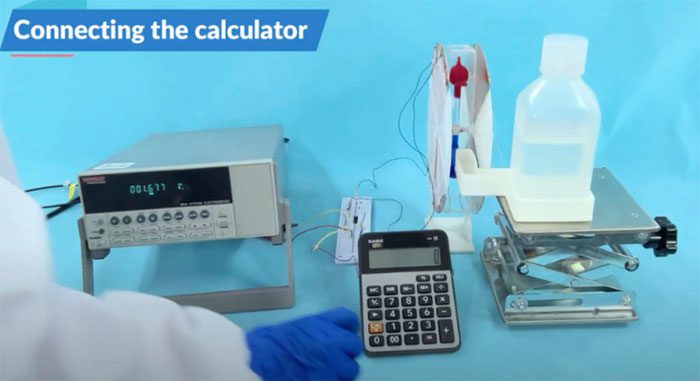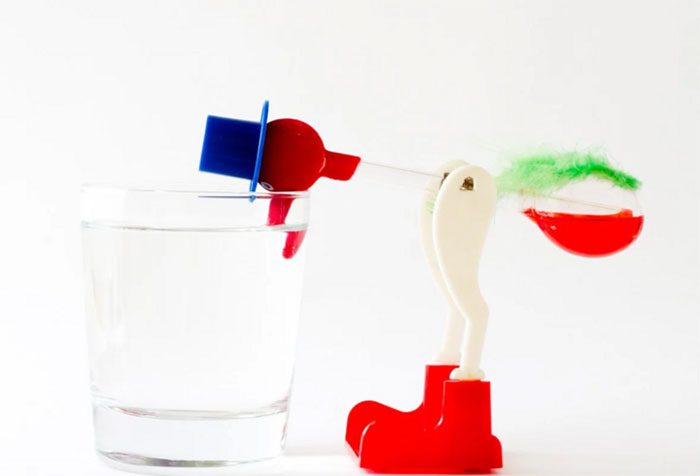Chinese scientists have developed a device that could pave the way for a new source of clean energy based on the principles of a classic toy.
A team of Chinese researchers has created a device that could lead to a new source of clean energy—an engine that can power small electronic devices through the process of water evaporation.
This device can operate on just 100ml of water as fuel for 50 hours, generating an output voltage of up to 100 volts, significantly higher than previous studies aimed at converting evaporative energy into electrical energy.

The Chinese research team has developed an engine capable of powering small electronic devices through the process of water evaporation, paving the way for a new source of clean energy. (Photo: SCMP)
In a paper published in the peer-reviewed journal Device, the research team stated: “Evaporative energy could be equivalent to half the solar energy on the surface of the Earth, offering significant opportunities for renewable energy.
Using a prototype generator, we powered small electronic devices such as liquid crystal displays (LCDs), temperature sensors, and computers in ambient conditions using water as fuel.”
The research team comprises scientists from South China University of Technology in Guangzhou, Hong Kong Polytechnic University, and City University of Hong Kong.
Their idea was inspired by the classic science toy “The Drinking Bird”—a toy that continuously dips its beak into a glass of water thanks to principles of thermodynamics. This device was invented by American chemist Miles Sullivan in the 1940s.

The classic science toy “The Drinking Bird” is based on simple thermodynamic principles. (Photo: SCMP)
Albert Einstein is said to have spent three and a half months studying this concept without success. Now, the mechanism behind this classic toy is being utilized to create a new renewable energy source.
The drinking bird consists of two glass bulbs connected by a long glass tube, with the lower bulb containing a liquid that boils at 40 degrees Celsius. The upper bulb is fitted with a “beak” covered in a material resembling felt.
To initiate the drinking motion, the bird’s beak is dipped into a glass of water. The water that comes into contact with the felt begins to evaporate, cooling the head more than the base. As the bird’s head cools, steam from the liquid inside the tube condenses, causing the pressure inside the head to decrease compared to the base.
This pressure differential causes the liquid at the base to rise toward the head. As the head becomes heavier, it dips back into the glass of water. After tilting forward, the liquid flows back down, and the bird returns to an upright position. As steam continues to evaporate at the head, the bird rocks back and forth, continuously “drinking” water.
Inspired by decades of curiosity, the research team decided to elevate this invention by harnessing mechanical energy on both sides of the bird. To accomplish this, they installed two friction nano-generator modules at each end.
“We use a natural thermal engine that operates on the principle of evaporation inspired by the drinking bird toy to convert latent heat of evaporation into low-frequency motion, and then convert mechanical energy into electrical energy through specialized friction nano-generators,” the research team stated.
Leading the research, Professor Wang Zuankai from Hong Kong Polytechnic University mentioned that their research is just a proof-of-concept for a theory, and the team hopes to develop devices that can more efficiently convert evaporative energy into electrical energy.
“We could line up dozens of mini drinking bird models printed in 3D into a nest to generate electricity simultaneously,” Professor Wang stated.
Another approach to make the bird “drink” involves shining sunlight on the glass bulb behind it, which can be coated with photothermal material. Professor Wang noted that heat from sunlight would cause the liquid inside to evaporate and create mechanical motion.
“In this way, we can convert light energy into electricity,” he said. “Since the liquid is contained within the tube, it will not be lost during the evaporation process.”
Professor Wang added that the research team could also apply a previously developed structure to the bird’s tube to accelerate the fluid movement, thereby generating more electricity.


















































